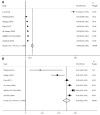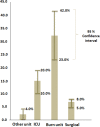Prevalence and Predictive Factors for Nosocomial Infection in the Military Hospitals: A Systematic Review and Meta-Analysis
- PMID: 34178764
- PMCID: PMC8213630
- DOI: 10.18502/ijph.v50i1.5072
Prevalence and Predictive Factors for Nosocomial Infection in the Military Hospitals: A Systematic Review and Meta-Analysis
Abstract
Background: To assess prevalence and predictive factors for Nosocomial Infection (NI) in the military hospitals.
Methods: PubMed, Scopus, Cochrane and PreQuest databases were systematically searched for studies published between Jan 1991 and Oct 2017 that reported the prevalence of NI and predictive factors among military hospitals. We performed the meta-analysis using a random effects model. Subgroup analysis was done for heterogeneity and the Egger test to funnel plots was used to assess publication bias.
Results: Twenty-eight studies with 250,374 patients were evaluated in meta-analysis. The overall pooled estimate of the prevalence of NI was 8% (95% 6.0-9.0). The pooled prevalence was 2% (95% CI: 2.0-3.0) when we did sensitivity analysis and excluding a study. The prevalence was highest in burn unit (32%) and ICU (15%). Reported risk factors for NI included gender (male vs female, OR: 1.45), age (Age≥65, OR: 2.4), diabetes mellitus (OR: 2.32), inappropriate use of antibiotics (OR: 2.35), received mechanical support (OR: 2.81), co-morbidities (OR: 2.97), admitted into the ICU (OR: 2.26), smoking (OR: 1.36) and BMI (OR: 1.09).
Conclusion: The review revealed a difference of prevalence in military hospitals with other hospitals and shows a high prevalence of NI in burn units. Therefore careful disinfection and strict procedures of infection control are necessary in places that serve immunosuppressed individuals such as burn patient. Moreover, a vision for the improvement of reports and studies in military hospitals to report the rate of these infections are necessary.
Keywords: Military hospital; Nosocomial infection; Predictive factors.
Copyright © 2021 Teymourzadeh et al. Published by Tehran University of Medical Sciences.
Conflict of interest statement
Conflict of interest The authors declare that there is no conflict of interests.
Figures



Similar articles
-
Prevalence of and risk factors for Plasmodium spp. co-infection with hepatitis B virus: a systematic review and meta-analysis.Malar J. 2020 Oct 15;19(1):368. doi: 10.1186/s12936-020-03428-w. Malar J. 2020. PMID: 33059662 Free PMC article.
-
Prospective analysis of nosocomial infections in a burn care unit, Turkey.Indian J Med Res. 2009 Dec;130(6):758-64. Indian J Med Res. 2009. PMID: 20090139
-
Prevalence of type 2 diabetes mellitus among hepatitis C virus-infected patients: a protocol for systematic review and meta-analysis.Syst Rev. 2019 Feb 25;8(1):60. doi: 10.1186/s13643-019-0976-x. Syst Rev. 2019. PMID: 30803444 Free PMC article.
-
The prevalence and risk factors of sarcopenia in patients with type 2 diabetes mellitus: a systematic review and meta-analysis.Diabetol Metab Syndr. 2021 Sep 3;13(1):93. doi: 10.1186/s13098-021-00707-7. Diabetol Metab Syndr. 2021. PMID: 34479652 Free PMC article.
-
Healthcare-associated infection and its determinants in Ethiopia: A systematic review and meta-analysis.PLoS One. 2020 Oct 23;15(10):e0241073. doi: 10.1371/journal.pone.0241073. eCollection 2020. PLoS One. 2020. PMID: 33095807 Free PMC article.
Cited by
-
Impact of diabetic ketoacidosis on outcomes in hospitalized diabetic patients with Clostridioides difficile infection: a national inpatient analysis.Proc (Bayl Univ Med Cent). 2024 Jun 3;37(5):742-748. doi: 10.1080/08998280.2024.2356782. eCollection 2024. Proc (Bayl Univ Med Cent). 2024. PMID: 39165815 Free PMC article.
-
Assessment effects and risk of nosocomial infection and needle sticks injuries among patents and health care worker.Toxicol Rep. 2022 Mar 2;9:284-292. doi: 10.1016/j.toxrep.2022.02.013. eCollection 2022. Toxicol Rep. 2022. PMID: 35273903 Free PMC article. Review.
References
-
- Allegranzi B, Nejad SB, Combescure C, et al. (2011). Burden of endemic healthcare-associated infection in developing countries: systematic review and meta-analysis. Lancet, 377(9761): 228–41. - PubMed
-
- Pashman J, Bradley E, Wang H, et al. (2007). Promotion of hand hygiene techniques through use of a surveillance tool. J Hosp Infect, 66(3): 249–54. - PubMed
-
- Mansour MGE, Bendary S. (2012). Hospital-acquired pneumonia in critically ill children: Incidence, risk factors, outcome and diagnosis with insight on the novel diagnostic technique of multiplex polymerase chain reaction. Egypt J Med Hum Genet, 13(1): 99–105.
-
- Starfield B. (2000). Is US health really the best in the world? JAMA, 284(4): 483–5 - PubMed
Publication types
LinkOut - more resources
Full Text Sources
